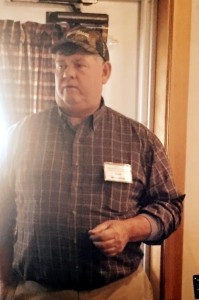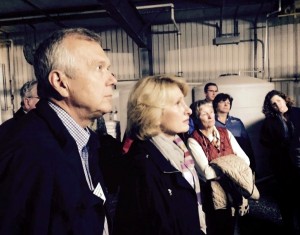On November 6 members, friends and presenters gathered at the Blair View Farm in Houston, Delaware to view first-hand the emerging aquaculture industry.
How does a traditional farm diversify and make use of their land in an innovative way? Twenty two PSPA members and their guests had the privilege of visiting Blair View Farm in Delaware to see their aquaculture facility. The farm also produces field crops, vegetables and beef cattle as well as continuing to raise their prize Red Angus cattle. Society members were joined by University engineering professor Dr. James Glancey, P.E., and several members of the University’s Cooperative Extension Service staff. Dr. Glancey, and his students, have played a key role in designing and implementing new equipment for the aquaculture operation at Blair View.
Walking in to one of the two aquaculture buildings, the tropical atmosphere quickly surrounds us. Tilapia are tropical fish so they need a warm environment. The round tanks are a mass of movement particularly when the floating feed is applied. Like everything else in this operation the feed is high tech, high protein and contains everything that the fish need for optimal development. The conversion rate of feed for fish is around 1:1 and it take about 180 days for the fingerling fish to reach the desirable market size of around 1.5 lbs. The feed is expensive but about equal to the cost of oxygen, critical for the fish, and energy for the constant water circulation.
During the six months the water temperature and oxygen levels are constantly measured every few minutes. Water in the tanks is constantly circulated and filtered. Cleanliness is critical. Suitable equipment had to be developed in conjunction with suppliers to ensure the highly accurate determination of the various variables. Computers record each reading so that staff can monitor each tank all the time. At night Dustin Blessing and senior staff take it in turns to be within call so they must live within 20 minutes of the tanks. Only 0.5% of the initial number of fingerlings are lost – very low by any standard particularly when compared to poultry production. We could not help but be impressed by the high technology of the whole operation.
Around 600,000 lbs. of tilapia are marketed each year and delivered fresh in water tanks to high end markets. The Blessings, in conjunction with Southern States Cooperative, have developed their markets, mostly in Canada but also in Philadelphia and New York.
The Blessings have found a diversified business that is year round. Their pasture and crop fields provide the perfect means of disposing of the fish tank water which has been tested to ensure safety to crops, animals and groundwater. The usual nitrogen level makes a very small contribution to the 360 lbs. requirement of their 200+ bushel corn crops.
Their fish unit is high investment and requires huge attention to technology and detail. It not an enterprise for someone not interested in high technology, determination to be successful and passion for the business. However the Blessing family, father and son (grandfather only died recently) is a superb example of how such diversification can be really successful. We were grateful for the opportunity to visit Blair View Farm.
At lunch at the Bonz restaurant in Harrington, Delaware the group enjoyed tilapia fish as part of an excellent lunch. Along with lunch, Dr. Dennis McIntosh, an aquaculture expert on the faculty at Delaware State University, shared insights into the emerging aquaculture field worldwide. All in all a fine day which added immensely to the Society’s theme of sustainability. The Society wants to thanks Joel Blessing, his family and staff for making the trip so enjoyable and for opening their farm to our group. Members should be sure to sign up for every Society event – they’re just too good to miss!
DAA 11/11/2014



